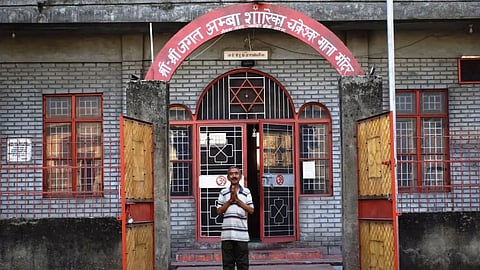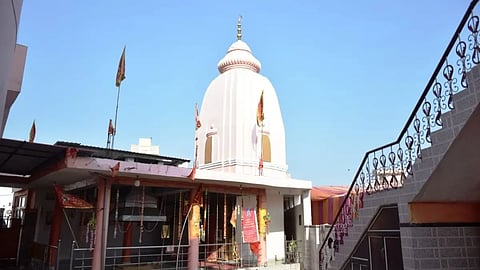Situated at a distance of about 25 km towards the northeast of Srinagar city, the historic Kheer Bhawani temple at Ganderbal’s scenic Tulmulla area has several stories. It is widely believed that water in the irregular septagonal pond — which surrounds the marble temple — keeps changing its colour. According to an old legend, when Sri Lanka’s king Ravana was killed by Lord Rama, Lord Hanuman brought Ragyna Bhagwati to Kashmir. Here, the Goddess got a new name, Kheer Bhawani. Kheer — rice cooked in milk and sugar — is believed to be her favourite dessert.
Kashmiri Pandits Of Jammu: Separated From Their Gods, Living With Replicas In Exile
Scores of replicas of the Hindu shrines in Kashmir that dot Jammu city — a second home to a majority of the displaced Kashmiri Pandits — reflect the community's resilience and resolve to preserve its cultural identity and religious traditions for the posterity.
When insurgency erupted in Kashmir in the early 1990s, the majority of the Kashmiri Pandits left the Valley amid a spate of targeted killings and ended up in Jammu, in need of a second home even as they strived to retain their identity. Eventually, as the uprooted community began to get a grip on this new life over the years, they constructed a replica of the temple in the labyrinthine lanes of Janipur in Jammu city - a replica of the shrine of Kheer Bhawani.
“The community was struggling to come to terms with their loss — which was not just about separation from our home and hearth. We as a community feel our umbilical cord has been cut, leaving us separated from our Gods and Goddesses as well,” says Kshama Kaul, a noted poetess and novelist, who has extensively written about what she describes as the ethnic cleansing of Kashmiri Hindus from Kashmir.
“The replica of the Kheer Bhawani temple symbolises collective pain of the community which has been forced to live in exile in its own country," Kaul says.
With a tinge of sadness, she recalls the words of the late Triloki Nath Ganjoo, a respected intellectual and academic in the community, saying, “Kheer Bhawani jahan hai, wohin hai na – Kheer Bhawani belongs to that place only, where it exists in reality!”
The Kheer Bhawani Bhawani replica is not an isolated case. Scores of replicas of the Hindu shrines in Kashmir dot Jammu city — a second home to a majority of the displaced Kashmiri Pandits — showcase the community's resilience and resolve to preserve its cultural identity and religious traditions for posterity.
Another such replica in Jammu’s Dhok Paloura is Mata Sharika of Hari Parbat, a hillock along the Dal Lake in Srinagar city that has many temples around it besides the main temple of Goddess Sharika or ‘Siddha Peetha’.

The incomplete replica of the Sharika shrine, however, is also an example of Jammu’s flailing urban planning. The caretakers at the shrine complain that the front yard of the shrine gets waterlogged during rains due to the poor drainage system in the area. Satisar Foundation — an organisation that works for the preservation of the Kashmiri Pandit identity — also runs its office from this shrine.
The community has also constructed a replica of the Sun temple 'Martand at Paloura', as a tribute to the original ruins of the historic temple — where the songs ‘Tere bina zindagi se koi shikwa to nahin’ (Aandhi) and Bismil (Haider) have been shot — is located at Anantnag’s Mattan town that basks in the glory of the walnut, apple, poplar and pine trees with streams of freshwater meandering through the sprawling farms.
Jammu is also home to replicas of Anantnag’s Uma Devi Shrine. It has been constructed along with an artificial spring at Uma Nagri, Muthi. The replica of the Sharda temple Bandipora and the Pukhribal shrines have also been constructed at Bantalab.

The replica of Ganesh temple Hanand Chawalgam has been set up at Ganesh Bihar Muthi and the Peer Pandit Badshah shrine has been replicated near BSF Headquarters along the Akhnoor highway. And among others, the replica of Baramulla’s Shailputri temple has been replicated at Gole Gujral Jammu.
Interestingly, several lanes and localities in Jammu city have also been named by displaced Pandits in keeping with their cultural heritage. Many well off Pandit families, who own houses in Jammu, have planted Chinar trees in their courtyards to symbolise the valley.
Even after 32 years since the displacement, RL Bhat, author of ‘Hindu Shrines of Kashmir’, says, “the Kashmiri Pandits are hopelessly connected to Kashmir – whether it is the local fruits, the landscape or the shrines. They probably can't live without imagining those things around them.”
Away from Kashmir, Bhat continues, “Our Maha Shivratri celebrations are considered incomplete without walnuts. We celebrate our new year with a chunk of earth that has green topping as we used to do in Kashmir. The establishment of cultural icons at different places in Jammu city is a continuation of that sentiment among the displaced people".
Elaborating further on how the replica shrines represent the cultural connection of the displaced Pandits, Bhat explains, “The influence of Semitic religions, with their particularisation of the divine in personas and agents, has misled some to narrow down their spiritual ideation. Nevertheless, Kashmiri Shaivism like Shankara’s system stands out as part of the Advaita school, which includes the whole universe — living and non-living — in its sweep. Here a mound of earth is as much an object of reverence as a person or god. Such objects can help reinforce their connection to Kashmir and define the importance of Kashmiri culture, their land and their holy shrines.”
Prominent intellectuals among the displaced Pandits believe that Islam became the majority religion in Kashmir during the reign of Sikandar Shah, also known as Sikandar Butshikan, in the 13th century. After his reign was over, Hinduism and Islam, coexisted without any major trouble until the eruption of armed insurgency. Besides a spate of targeted killings, attempts were also made to erase the Hindu heritage of the state during this phase.
Anantnag district, for example, became Islamabad for the majority community. Gopadri, the hill where the ancient Shankracharya temple stands, became Takht-e-Suleiman and Hari Parbat — which overlooks Srinagar town — was renamed as Koh-e-Maran. A similar trend was previously followed in Pakistan Occupied Kashmir (POK) soon after the ethnic cleansing of Hindus and Sikhs.
According to RL Bhat, the nomenclature started to change in Jammu and Kashmir when historians started recording Kashmir's history in Persian during and after the 17th century.
“During militancy, the militants reinforced Persian names of the places. They would punish even those local Muslims who would refer to the famous places by their old Hindu names,” Bhat claims.
Of late, the Union Territory administration has taken steps to renovate historic temples in Kashmir. For example, the famous Raghunath Temple on the bank of river Jhelum at Fateh Kadal in Srinagar was opened in September 2020 after 30 years. The restoration work on Martand Sun Temple is also underway.
In fact, there has been a longstanding demand for a full-fledged law in accordance with the provisions of the Kashmiri Pandits’ Temples and Shrines Bill.
“We want a law, which provides for establishment of a Temple and Shrine Board in Kashmir, just like the Wakf Act and Gurudwara Prabandhak Committee Act for Muslim and Sikh communities. But due to political reasons, successive governments have remained unmoved so far,” says Tej Krishan Bhat, a Jammu based former general secretary of All State Kashmiri Pandit Conference.
Lamenting the encroachment of the religious shrines in Kashmir, Bhat also demanded that a corridor from Teetwal on the Indian side of Kashmir to Sharda Temple inside PoK be opened along the lines of the Kartarpur Corridor at the Punjab border between India and Pakistan.
“Shardha Peeth defines the existence of Kashmiri Pandits. Therefore, we must get access to it. We have taken up the matter with both the government of India and Pakistan,” he says, claiming that the local residents of Neelam valley across the LoC have also supported the community's demand.